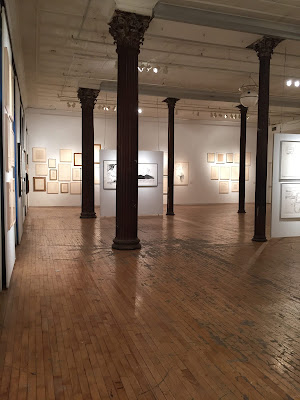 On Sunday, January 27, I attended the opening of New York Academy of Art’s Andy Warhol: By Hand. I was surprised and delighted to find that I was the only patron in the main gallery of this tiny, out-of-the-way art school in Tribeca – of which Warhol was a founding board member – and I relished in the absolute silence as I took my time absorbing each and every drawing on display. I have never before, and likely will never again, experience an empty gallery in New York City.
On Sunday, January 27, I attended the opening of New York Academy of Art’s Andy Warhol: By Hand. I was surprised and delighted to find that I was the only patron in the main gallery of this tiny, out-of-the-way art school in Tribeca – of which Warhol was a founding board member – and I relished in the absolute silence as I took my time absorbing each and every drawing on display. I have never before, and likely will never again, experience an empty gallery in New York City.I have paid Andy Warhol a great deal of attention over the course of my life as an artist. I have written research papers and book reports about him, read about his life, work, and social scene (and hangers on) in New York, and always keep an eye on the Decker building in Union Square, the last site of his Factory. I have watched documentaries, attended exhibitions, and carry his more famous works around in the form of several canvas tote bags. You could say I’m a fan; inexplicably drawn to anything Warhol.
However, in all my research, his drawings, some of his earliest works, rarely come up. The exhibition featured still lifes; sketches of hands, feet, and genitalia; portraits; landscapes from travels; animals; and various commissioned works for advertisements. Apart from the artist’s self-portrait, all of these drawings were new to me. The current Warhol retrospective at the Whitney (for which NYAA’s show was planned to compliment) also features some lesser-known works, but not to the magnitude of this much smaller exhibition.

Monday, February 11, I attended NYAA’s panel discussion hosted by David Kratz, President of the Academy, speaking with Vincent Fremont, curator of the exhibition and former executive studio manager of the Factory, and John Giorno, performance artist, former Warhol model, and star of Warhol’s film “Sleep.”
 |
| From left: NYAA President David Kratz, Vincent Fremont, and John Giorno |
During the discussion, I gained an insight into Andy Warhol that only those who had known him could have provided:
Vincent met Andy at Woodstock in 1969. He and a group of friends came to the city soon after and stayed at the Chelsea Hotel. He interviewed with Andy the next day and was appointed executive studio manager of the Factory. Vincent relayed that Andy was a different person to everyone he knew, with many different layers, and that Andy was an “energy gatherer,” exuding a magnetic pull that drew so many different types of people to him. Accessible to the press, Andy understood commerce but never “sold out,” making the claim that “business is the best art.” Andy preferred to listen and record others speaking rather than speaking himself. Vincent met Andy after Valerie Solanas’ assassination attempt and noted that this event was catastrophic to the artist, affecting Andy psychologically and stifling his work for a long time afterward: he no longer went to Max’s Kansas City, a favorite haunt; he photographed his scarred body, over which he wore a corset for the rest of his life; and as death was an abstraction to Andy, the trauma caused confusion of what was real and what was not.
As for Andy’s drawings, Vincent explained that some of the pieces, especially those done while travelling the world were created as visual journals. A small heart drawn on a portrait was an indication that Andy cared for the person he was illustrating, and he referred to nude portraits as “landscapes,” a fact I really enjoy. A majority of the drawings on display were done from life, with the exception of several illustrations of children copied from photographs in LIFE Magazine. In Vincent’s words, Andy looked at the world more differently than anyone else.
John met Andy in 1962, and described the artist as kind, gentle, simple, and brilliant; a force in the art world because the things he was doing were being done for the first time. John enjoyed Andy’s mind: any time Andy said something interesting, John would write it down and make up a question for it, like a backward interview, and called the series, “Andy Warhol Interviewed by a Poet.” John, a gay rights activist, mentioned that the abstract art scene in the 1950’s was extremely homophobic, and Andy was rejected from the Tanger gallery for being gay, but as Vincent said, Andy soon became a force in the gay art scene. John believes the self-portrait on display, made toward the end of Andy’s life, may have been precognition, and anticipation of his own death, and that the hair of his legendary wig sticking up may be symbolic of Andy’s belief that the “best way to leave your body is through the top of your head.”
John said, “Andy’s art is autobiographical and a reflection of his mind,” and also, “Artists talk to you, but they’re really talking to themselves about what they’re [creating].” I am always hungry for new insights and perspectives, especially if they can impact any preconceived notions I’ve developed. Listening to these two men expound upon a man both so public yet shrouded in mystery, explaining not only his work but his carefully curated self-image, was a great privilege.
 |
| © 2019 The Andy Warhol Foundation for the Visual Arts, Inc. / Licensed by Artists Rights Society (ARS), New York Artwork courtesy Private Collection |
No comments:
Post a Comment